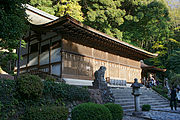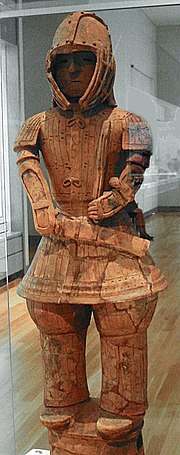| This page is currently inactive and is retained for historical reference. Either the page is no longer relevant or consensus on its purpose has become unclear. To revive discussion, seek broader input via a forum such as the village pump. |
To add a new National Treasure to this list:
- Create a new page that is after the last page in numbering (eg if the last page was Portal:Ancient Japan/Selected National Treasure/7 then you create Portal:Ancient Japan/Selected National Treasure/8)
- Copy the format from one of the existing pages (using the template {{Portal:Ancient Japan/Selected National Treasure/Layout}}).
- Update the max value on this page (change the number in the template {{Numbered subpages}}) and update the max value on the Portal for Selected National Treasure
Selected National Treasure 1
Portal:Ancient Japan/Selected National Treasure/1
Ōsaki Hachimangū (大崎八幡宮) is a Shinto shrine in Aoba-ku, Sendai, Miyagi, Japan. The main shrine building (社殿, shaden) has been designated a National Treasure of Japan. (Full article...)Selected National Treasure 2
Portal:Ancient Japan/Selected National Treasure/2
Nikkō Tōshō-gū (日光東照宮) is a Tōshō-gū Shinto shrine located in Nikkō, Tochigi Prefecture, Japan.Together with Futarasan Shrine and Rinnō-ji, it forms the Shrines and Temples of Nikkō UNESCO World Heritage Site, with 42 structures of the shrine included in the nomination. Five of them are designated as National Treasures of Japan, and three more as Important Cultural Properties. (Full article...)
Selected National Treasure 3
Portal:Ancient Japan/Selected National Treasure/3
The Ujigami Shrine (宇治上神社, Ujigami-jinja) is a Shinto shrine in the city of Uji, Kyoto Prefecture, Japan. The shrine was built as a guardian shrine for the nearby Byōdō-in, and is adjacent to the Uji Shrine. In 1994, it was registered as a UNESCO World Heritage Site as one of the "Historic Monuments of Ancient Kyoto". The honden and haiden have been designated by the Agency for Cultural Affairs as National Treasures in the category shrines.The Ujigami Shrine is dedicated to the Emperor Ōjin and his sons, the imperial princes Uji no Wakiiratsuko and Emperor Nintoku. Uji no Wakiiratsuko committed suicide to solve a dispute over the imperial succession, and the shrine was built in his honor. (Full article...)
Selected National Treasure 4
Portal:Ancient Japan/Selected National Treasure/4
Hiyoshi Taisha (日吉大社) is a Shinto shrine located in the city of Ōtsu, Shiga Prefecture Japan. This shrine is one of the Twenty-Two Shrines. Known before World War II as Hiei Taisha (日枝大社) or Hie jinja, "Hiyoshi" is now the preferred spelling. It was also known as the Sanno Gongen (山王権現). The head shrine in Ōtsu heads the seventh largest shrine network in Japan, with approximately 3800 Hiyoshi, Hie, and Sannō shrines nationwide. Torii of this shrine have a distinctive configuration, known as the "Sannō torii", with a gaggle above the main crossbeam. The 400,000 square meter precincts centered is designated as a National Historic Site, and the east and west main shrine buildings, the Nishi Hongū (西本宮) and Higashi Hongū (東本宮) are designated as National Treasures, and many of the structures in the precincts are designated as National Important Cultural Properties. (Full article...)Selected National Treasure 5
Portal:Ancient Japan/Selected National Treasure/5
The Record of a Pilgrimage to China in Search of the Law (入唐求法巡禮行記, nittō guhō junreikōki) is a four-volume diary written by Ennin, a Japanese Buddhist monk in China during the ninth century. He was one of eight Japanese Buddhists who studied in China at that time. He wrote his diary while he went on a Buddhist pilgrimage to China for nine and a half years (838–847). The books are translated into English as two volumes by Professor Edwin O. Reischauer of Harvard University under the title Ennin's Diary: The Record of a Pilgrimage to China in Search of the Law (Ronald Press, New York: 1955) and Ennin's Travels in T'ang China. The first volume is a translation of Ennin's Diary. The second volume, a discussion of Ennin's travels, includes materials from other sources.Ennin's travel books are precious as historical sources, although they have some errors. His book was the first written document about China and its life by a foreigner. He did not write an evaluation of what he saw, but rather wrote about religious matters and Chinese life under the Tang dynasty. His diary is a good source on the practice of popular Buddhism in China. He described ceremonies as well. He brought back many sutras and mandalas to Japan. He struggled in his travel during the Tang's persecution of Buddhism (842–846). (Full article...)






